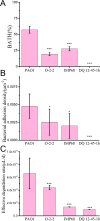Dynamics of microbial-induced oil degradation at the microscale
- PMID: 39436126
- PMCID: PMC11619474
- DOI: 10.1128/spectrum.01176-24
Dynamics of microbial-induced oil degradation at the microscale
Abstract
Microbial-induced oil degradation (MIOD) has a wide range of applications, such as microbial enhanced oil recovery and bioremediation of oil pollution. However, our understanding of MIOD is still far from complete. Particularly, how is the dynamics of degradation process at the microscale level with a single-cell resolution remains to be disclosed. In this work, using hexadecane droplets in water as a model system, we have studied the dynamics of hexadecane degradation by different strains, including Pseudomonas aeruginosa PAO1, IMP68, O-2-2, and Dietzia sp. DQ12-45-1b, at the microscale. Based on visualization of MIOD, the dynamics of MIOD can be characterized by a three-stage process, including adhesion, adaptation, and degradation stages. Although different strains showed similar three-stage dynamics of MIOD, the effective degradation rate varied and followed an order of PAO1 > O-2-2 > IMP68 > DQ12-45-1b under aerobic conditions. Different oxygen conditions were also tested, and the dynamics of MIOD was slowed down under anaerobic conditions in comparison to under aerobic conditions. Further investigations at the degradation stage revealed that biofilms formed at the oil-water interface enhanced oil degradation, but a prerequisite for such enhanced degradation is proper stimulation of biofilm cells in the course of biofilm formation. The findings in this work provided a detailed picture on the dynamics of MIOD at the microscale and would be beneficial for better applications of MIOD.IMPORTANCEMicrobial-induced oil degradation is environmental friendly and economic and has become a promising technique in the fields of enhanced oil recovery and remediation of crude oil-polluted environments. For better applications of microbial-induced oil degradation, understanding the degradation dynamics particularly at the microscale is crucial. In this study, we investigated the degradation dynamics of hexadecane oil droplets incubated with different strains, including Pseudomonas aeruginosa PAO1, O-2-2, IMP68, and Dietzia sp. DQ12-45-1b at the microscale by employing microdroplet-based methods and bacterial tracking techniques. The findings in this study provided a detailed picture on the dynamics of microbial-induced oil degradation at the microscale, which will deepen our understandings on the biodegradation mechanisms of alkanes and shed insights for developing more effective biodegradation techniques.
Keywords: Dietzia sp.; Pseudomonas aeruginosa; biofilm; bioremediation; oil-water interface.
Conflict of interest statement
The authors declare no conflict of interest.
Figures



References
-
- Dopffel N, Kögler F, Hartmann H, Costea PI, Mahler E, Herold A, Alkan H. 2018. Microbial induced mineral precipitations caused by nitrate treatment for souring control during microbial enhanced oil recovery (MEOR). Int Biodeterior Biodegrad 135:71–79. doi:10.1016/j.ibiod.2018.09.004 - DOI
-
- Binazadeh M, Karimi IA, Li Z. 2009. Fast biodegradation of long chain n-alkanes and crude oil at high concentrations with Rhodococcus sp. Moj-3449. Enzyme Microb Technol 45:195–202. doi:10.1016/j.enzmictec.2009.06.001 - DOI
LinkOut - more resources
Full Text Sources

